Where will the 2027 total solar eclipse on Aug. 2 be visible?
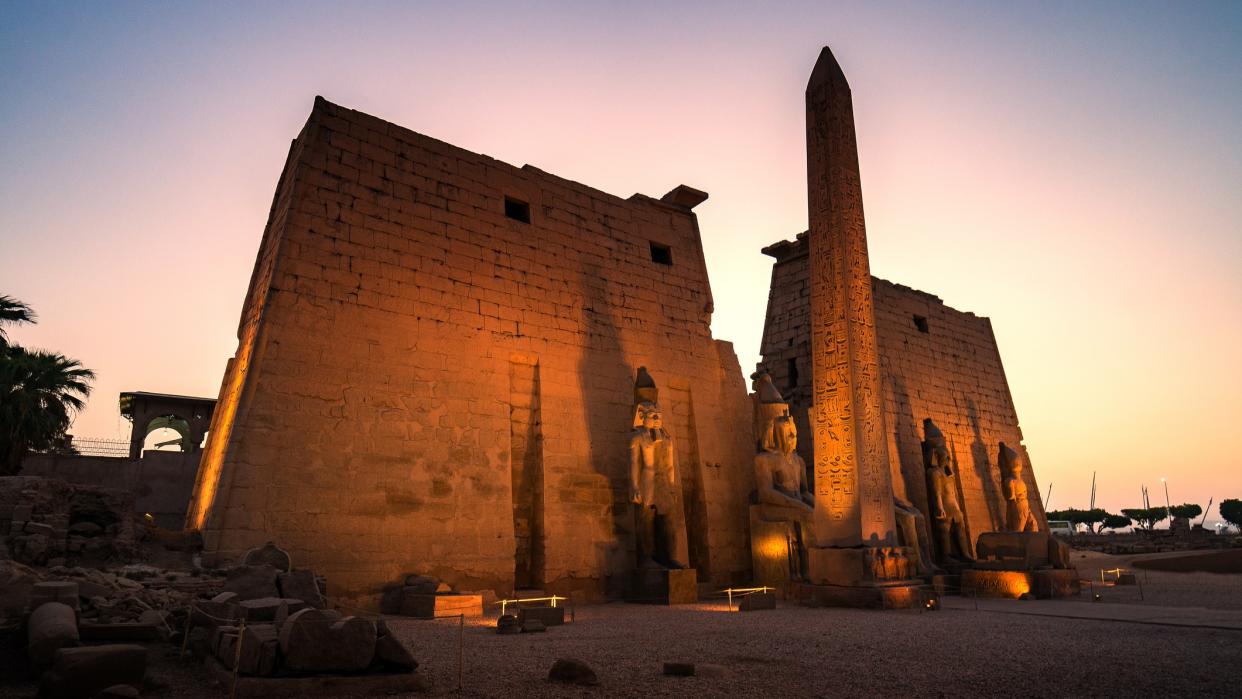
A total solar eclipse will occur on Aug. 2, 2027, when the moon's central shadow sweeps across the globe, bringing a few precious minutes of totality to the Atlantic Ocean, southern Europe, North Africa and the Middle East.
At the point of greatest eclipse, totality will last 6 minutes and 23 seconds, the longest since 2009 and until 2114.
During a total solar eclipse, looking directly at the sun during the partial phases is unsafe without solar eclipse glasses designed for solar viewing. Read our guide on how to observe the sun safely.
Related: What is a solar eclipse?
Where the total eclipse will be visible globally
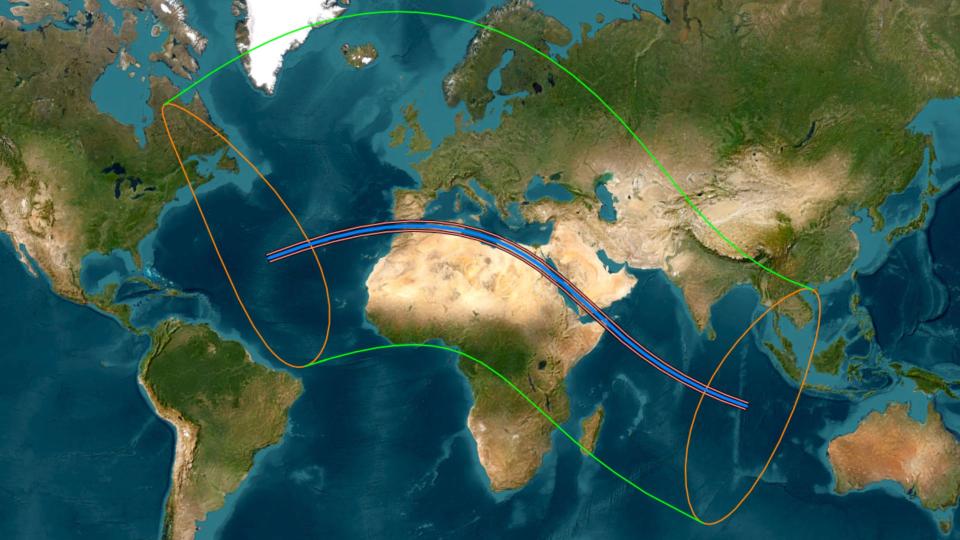
This 2027 total solar eclipse has a long and broad path of totality, rising in the Atlantic Ocean (for a 3 minutes 5 seconds "sunrise totality") to the west of the Azores and Madeira and setting just west of the Cocos (Keeling) Islands in the Indian Ocean. That journey is 9,462 miles (15,227 kilometers), during which the moon's central umbral shadow will be 160 miles (258 km) wide and take three hours and 20 minutes to move across the planet.
According to Timeanddate, about half of the path crosses land, and a whopping 88.9 million people will witness totality that day in 12 nations: Spain, Morocco, Algeria, Tunisia, Libya, Egypt, Sudan, Saudi Arabia, Yemen, Somaliland, Somalia and the Chagos Islands.
Related: What's the difference between a total solar eclipse and an annular solar eclipse?
Total eclipse visibility in Spain and Morocco
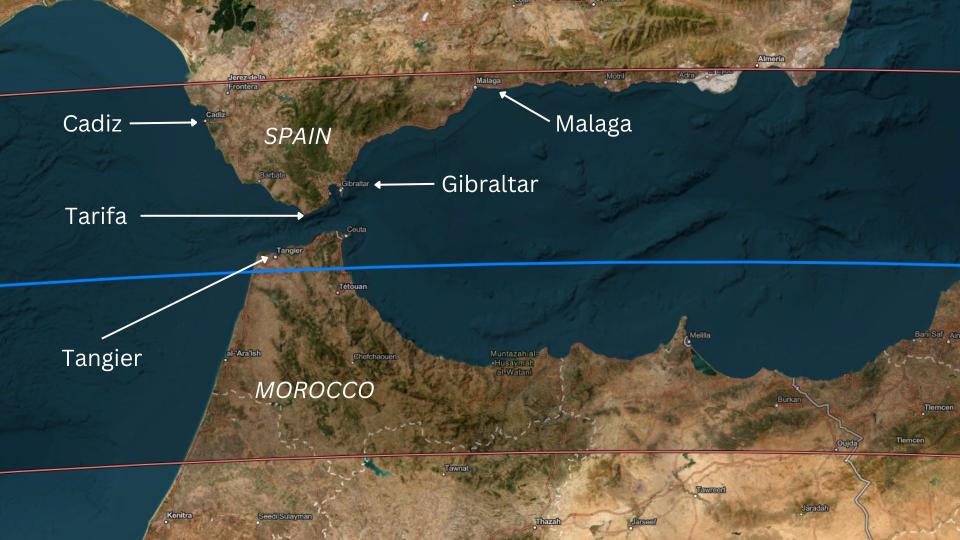
Although it's often called the "Great North African Eclipse," millions will watch from Spain's southern province of Andalusia. Tourism highlights in this province include Seville's Alcázar castle, Córdoba's Mezquita Mosque-Cathedral and Granada's Alhambra Palace. However, the path of totality crosses south of all of those locations. While Malaga on the shores of the Mediterranean and Cadiz on the southwest coast get short totalities, it's to the southern tip at Tarifa, Algeciras and Gibraltar that eclipse chasers should head for a long totality of up to 4 minutes 40 seconds.
Tangiers in Morocco is just a short ferry ride across the Strait of Gibraltar from Tarifa. Ferries also run between Algeciras in Spain and the Tanger Med industrial port.
At all of these locations, the entirely eclipsed sun will hang about 37 degrees above the eastern horizon.
Total eclipse visibility in North Africa
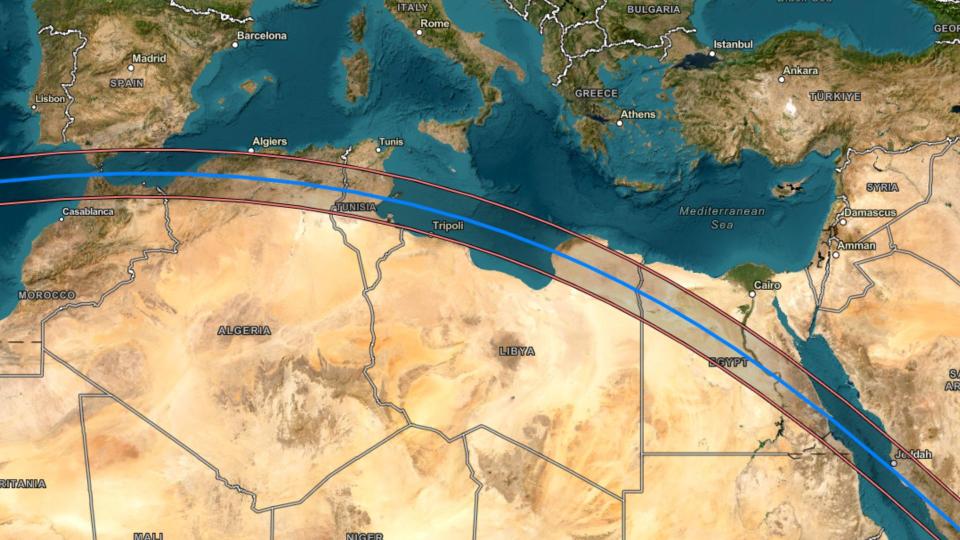
Totality on Aug. 2, 2027, is in North Africa. Almost the entire continent will witness totality before midday, with the sun eclipsed 37 degrees above east in Morocco and rising — and peaking — at the point of greatest eclipse at 82 degrees above south-southwest in eastern Egypt.
After Morocco witnesses a totality lasting as long as 4 minutes 52 seconds, it will be the turn of northern Algeria, central Tunisia, the Kerkennah Islands, extreme northwestern Tunisia and central Egypt. Just southeast of Luxor, Egypt, at the point of greatest eclipse, a totality lasting 6 minutes 23 seconds will be experienced.
Many of North Africa's largest cities miss out on totality, such as Algiers (99.7% partial solar eclipse), Tunis (96%) and Cairo (94%). However, the northwestern coast of Tripoli in Libya is just inside the path of a brief totality, and Benghazi is right on the centreline for a long 6-minute-9-second totality.
Total eclipse visibility in Egypt
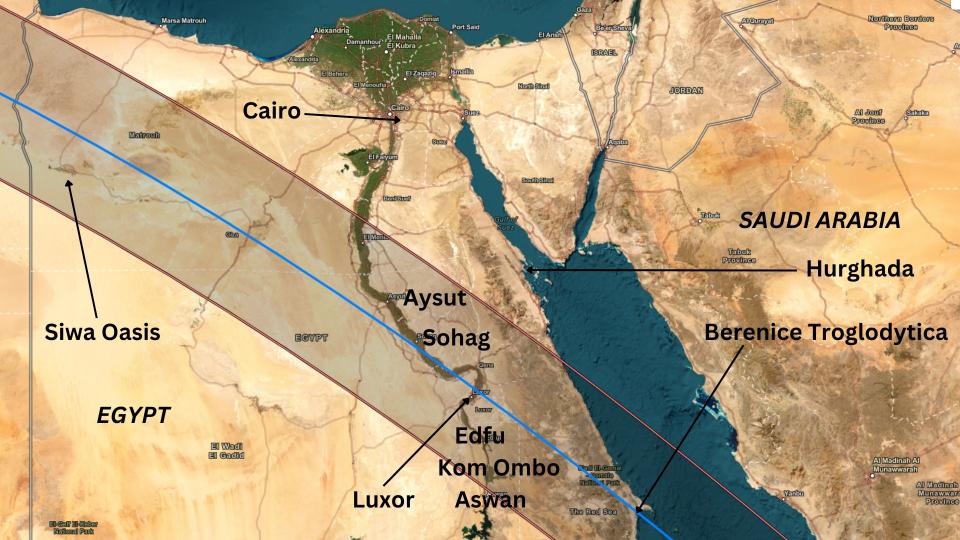
Egypt is the top destination for this eclipse, with the vast majority of tour groups heading to the country to see the Nile, desert landscapes and, of course, its magnificent monuments. The country's almost zero chance of clouds in August is another major drawcard.
Though the Giza Pyramids near Cairo are outside the path (they will see just a 95% partial solar eclipse), the ancient city of Thebes — modern Luxor — is very close to the point of greatest eclipse. An immense 6-minute 20-second totality will grace the Karnak and Luxor temples, the Colossi of Menmon, the Mortuary Temple of Hatshepsut and the Valley of the Kings and the Queens. The Nile will be buzzing with cruise boats and packed hotels.
There are other options in Egypt for a long totality. Siwa Oasis in the country's northwest will get 5 minutes 37 seconds. Popular tourist destination Aswan in the south misses out (99.8% partial solar eclipse), as does the famous Abu Simbel monument to its southwest (92%). However, between Aswan and Luxor are two famous Egyptian temples at Edfu and Kom Ombo. Meanwhile, just north of Luxor, but still close to the centerline, are Sohag (6 minutes 20 seconds) and Asyut (6 minutes 6 seconds).
The Red Sea coast of Egypt will also get a long totality. Although the hub for hotels and resorts in Hurghada to the north, it's only a two-hour drive into the path of totality at Quseer (2 minutes 31 seconds), with Port Ghalib (4 minutes 33 seconds) and Marsa Alam (5 minutes 30 seconds) beyond. On the centerline at the coast is Berenice Troglodytica (6 minutes 20 seconds), which has an airport and a sole hotel, the Wadi Lahmy Azur Resort.
Total eclipse visibility in the Middle East
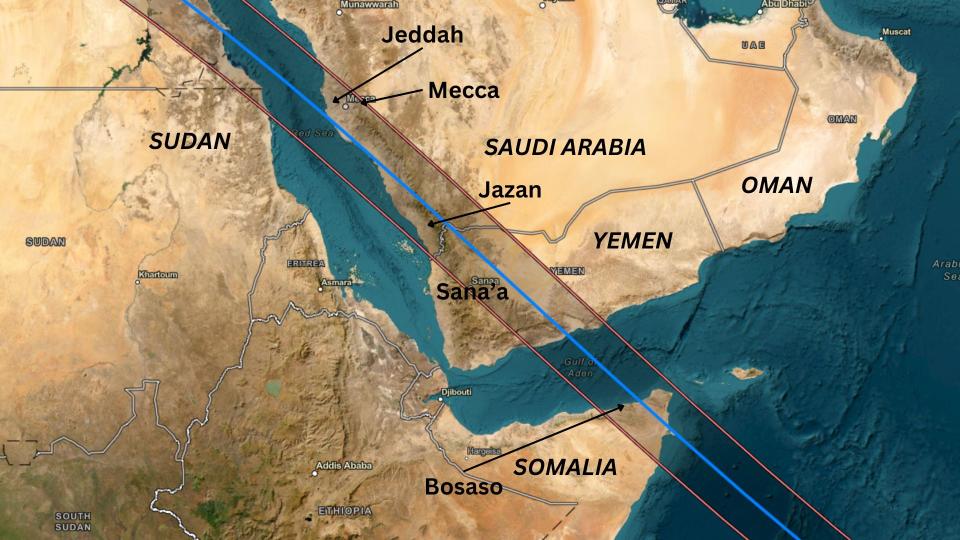
If passing over the ancient city of Thebes wasn't incredible enough, a long totality will also sweep across Mecca, the holiest city in Islam. Saudi Arabian port city Jeddah will see totality (6 minutes 1 second) 77 degrees above west-southwest before being seen from Mecca (5 minutes 5 seconds) and a long stretch of the on the Red Sea coast south to Jazan (2 minutes 57 seconds) close to the border with Yemen. Sana'a, the capital of Yemen, will see a short totality (2 minutes 20 seconds) before the moon's shadow crosses the Gulf of Aden and the tip of Somalia, where Bosaso (4 minutes, 58 degrees above west-northwest) is the only large settlement.
The umbra then envelopes the northern part of the Chagos Islands, with totality visible 21 degrees above northwest just north of the disputed British Indian Ocean Territory of Diego Garcia, home to a U.S. naval base. The moon's shadow then narrows just before leaving Earth west of Australia's remote territory of the Cocos (Keeling) Islands, parting with a "sunset totality" on the northwest horizon lasting a maximum of 3 minutes 4 seconds.
Editor's note:
You can read about the next decade of eclipses here on Space.com and in more detail in Jamie Carter's e-book "When Is The Next Eclipse? A traveler's guide to total solar eclipses 2026-2034."
"The book is full of 'secret' experiences that only a complete eclipse and travel nerd like me could find!" Carter told Space.com.
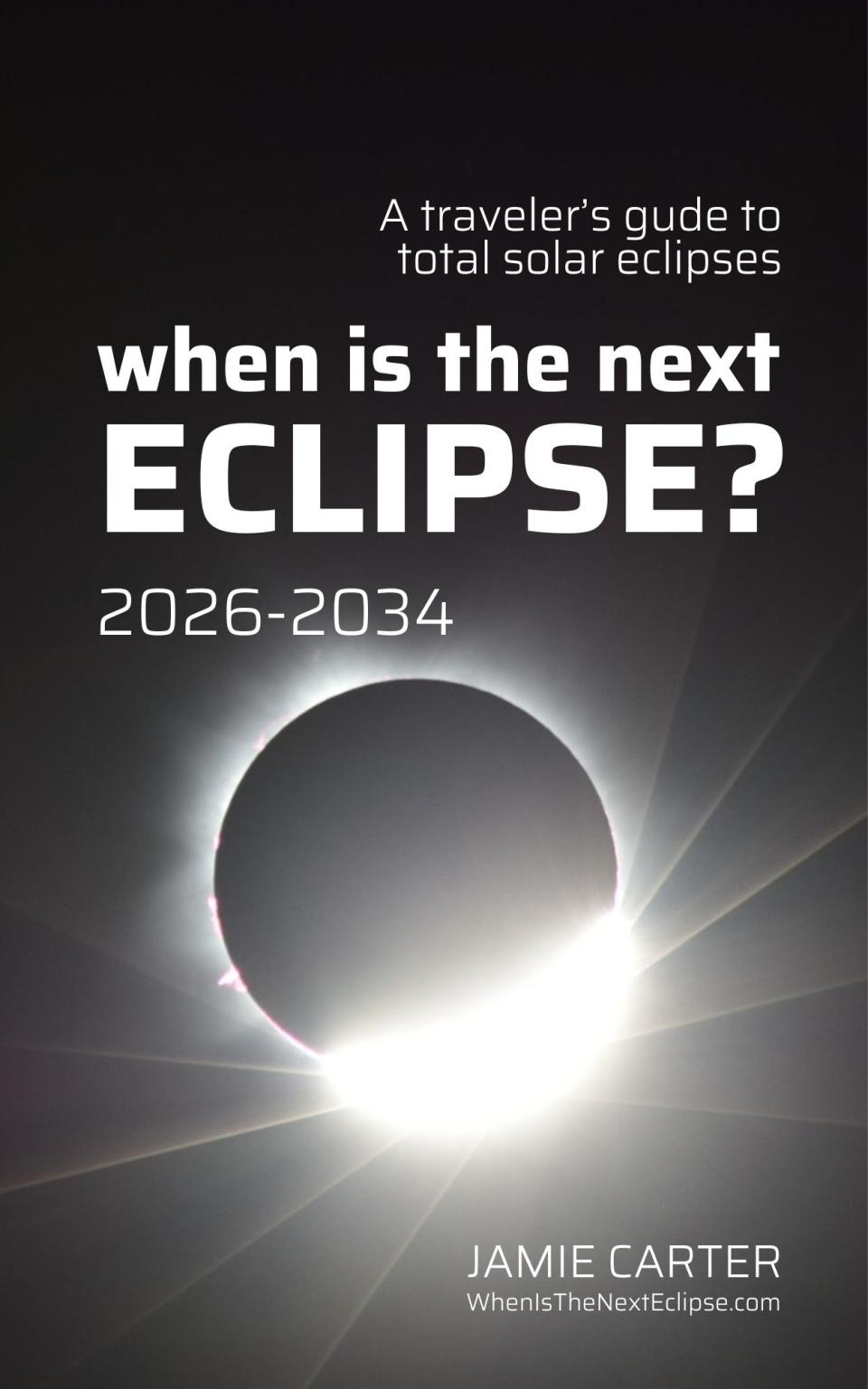
"When Is The Next Eclipse? A traveler's guide to total solar eclipses 2026-2034:" $9.99 from Amazon
Check out Jamie Carter's eclipse traveler guide "When Is The Next Eclipse? A traveler's guide to total solar eclipses 2026-2034" available on Amazon.View Deal
Additional resources
Want to look further ahead? You can find a concise summary of solar eclipses out to 2030 on NASA's eclipse website. Read more about solar and lunar eclipses on EclipseWise.com, a website dedicated to predictions of eclipses. See beautiful maps on eclipse cartographer Michael Zeiler's GreatAmericanEclipse.com and interactive Google Maps on Xavier Jubier's eclipse website. You can find climate and weather predictions by meteorologist Jay Anderson on eclipsophile.com.
Bibliography
Anderson, J. (May 2024). Eclipsophile: Future Eclipses. Retrieved May 15, 2024, from https://eclipsophile.com/future-eclipses-2024-2028/
Bakich, M. and Zeiler, M. (2022). Atlas Of Solar Eclipses 2020-2045. https://www.greatamericaneclipse.com/books/atlas-of-solar-eclipses-2020-to-2045
Espenak, F. Solar Eclipse Prime Page: Total Solar Eclipse of 2027 August 2. Retrieved May 15, 2024, from: https://eclipsewise.com/solar/SEprime/2001-2100/SE2027Aug02Tprime.html
Jubier, X. (n.d.). Solar eclipses: Interactive Google Maps. Retrieved May 15, 2024, from http://xjubier.free.fr/en/site_pages/SolarEclipsesGoogleMaps.html
Time and Date. (n.d.). August 2, 2024, Total Solar Eclipse. Retrieved May 15, 2024 from https://www.timeanddate.com/eclipse/solar/2027-august-2

